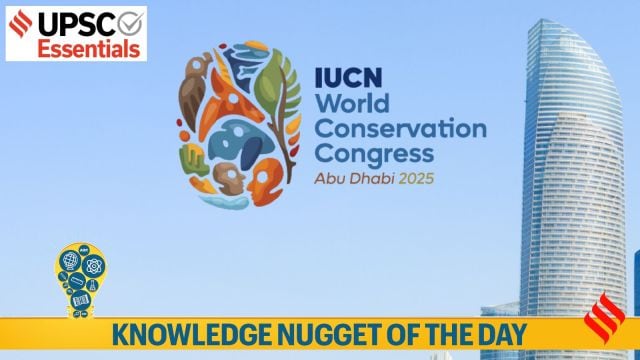
Why in the news?
Organised every four years, the International Union for Conservation of Nature (IUCN) World Conservation Congress took place in Abu Dhabi, United Arab Emirates, from 9 to 15 October 2025. Consisting of more than 1,400 member organisations, the Congress enables IUCN Member organisations to democratically determine the most pressing issues in nature conservation and actions to address them to help guide humanity’s relationship with our planet.
Key takeaways:
1. India’s ‘Red List’ system: India unveiled the roadmap for the national-level five-year (2025-2030) assessment. It aims to establish a nationally coordinated, participatory, and upgradable ‘Red Listing’ system that accurately reflects the conservation status of India’s biodiversity. It will assess the extinction risk of approximately 11,000 species, including 7,000 kinds of flora and 4,000 types of fauna — across the country to prepare a ‘national red list’.
2. India’s first dugong conservation reserve: A motion was adopted at the Congress to recognise India’s first dugong conservation reserve in Tamil Nadu’s Palk Bay as a global model for marine biodiversity conservation.
 Vivek Menon is the founder of the Wildlife Trust of India (WTI).
Vivek Menon is the founder of the Wildlife Trust of India (WTI).
3. New chair of Species Survival Commission (SSC): Vivek Menon, the founder of the Wildlife Trust of India (WTI), has been named as the new chair of the Species Survival Commission (SSC), making him the first Asian to hold the post. The SSC is one of the seven expert commissions under the global body that advises the IUCN secretariat on matters concerning biodiversity and species conservation. The commission and its specialist groups play a key role in preparing the IUCN’s red list of threatened species.
4. IUCN award for innovation in national parks: Sonali Ghosh, the Director of Kaziranga National Park and Tiger Reserve, has become the first Indian to receive the prestigious WCPA-Kenton Miller Award for innovation in national parks and protected area sustainability. The award was presented at the IUCN World Conservation Congress by the World Commission on Protected Areas (WCPA), a global body that recognises individuals who have made innovative contributions to wildlife area conservation.
Story continues below this ad
5. Wild animals as climate allies: A resolution was adopted to recognise the role of wild animals in ecosystems as enablers of natural solutions to tackle climate change. It marks a turning point in how the international community views wildlife – not just as species in need of protection, but as vital agents of planetary resilience.
6. Abu Dhabi Call to Action 2025: The IUCN Congress has unveiled the Abu Dhabi Call to Action, outlining a 20-year strategic vision that sets out IUCN’s vision for “a just world that values and conserves nature”.
For the next 20 years IUCN aims to fulfill the mission “to influence, encourage and assist societies throughout the world to conserve the integrity and diversity of nature and ensure that any use of natural resources is both equitable and ecologically sustainable”. It also adopted a four year programme 2026-2029, Nature 2030: One nature, one future, that defines the implementation plan.
7. Motion 42: For the first time, IUCN members also adopted Motion 42 on fossil fuel supply-side measures, calling for guidance on a just phaseout of coal, oil, and gas, supported by World Wildlife Fund and the Fossil Fuel Non-Proliferation Treaty Initiative.
Story continues below this ad
8. Motion 108: For the first time, the IUCN Congress has adopted the Motion 108 which calls for the creation of urgently needed global guidelines to help countries manage the commercial trade in wild animals kept as pets. It recognizes that the wildlife pet trade must be brought under control, as it poses mounting threats to biodiversity, animal welfare, human and animal health, and the rule of law.
 Indigenous Peoples have long sought recognition of their identities, way of life, and rights to traditional lands, territories, and natural resources. (Source: Freepik)
Indigenous Peoples have long sought recognition of their identities, way of life, and rights to traditional lands, territories, and natural resources. (Source: Freepik)
9. First-ever World Summit of Indigenous Peoples and Nature: This Summit was jointly convened by IUCN, the International Indigenous Forum on Biodiversity (IIFB), and IUCN Indigenous Peoples’ Organisation (IPO) Members. This first ever Summit organised from 8-10 October, marks a powerful turning point—an affirmation that Indigenous Peoples are not peripheral stakeholders, but rightful stewards of life on Earth.
10 .IUCN World Heritage Outlook 2025: The IUCN released the 4th World Heritage Outlook report which revealed that climate change threatens 43 percent of natural World Heritage sites. It revealed that only 57 percent of natural World Heritage sites now have a positive conservation outlook, down from 62 percent in 2020, as climate change, invasive species, and diseases intensify.
|
About IUCN
Created in 1948, IUCN was one of the first international organisations committed to the protection of nature. From then on, the Union has created the fertile ground that links governments, non-governmental organisations (NGOs) and Indigenous Peoples under one roof working together to conserve the integrity and diversity of nature. Today, it comprise of 160 member countries and hundreds of civil society groups that work together towards environmental and biodiversity protection. Story continues below this ad It has seven expert commissions which are the Commission on Education and Communication, Commission on Environmental, Economic and Social Policy, Commission on Ecosystem Management, Species Survival Commission, World Commission on Environmental Law, World Commission on Protected Areas, and Climate Crisis Commission. |
BEYOND THE NUGGET: About Dugong
 Dugongs are listed as Vulnerable on the IUCN Red List of Threatened Species. (Wikimedia Commons)
Dugongs are listed as Vulnerable on the IUCN Red List of Threatened Species. (Wikimedia Commons)
— The dugong (Dugong dugon), also called the sea cow, is a herbivorous mammal. They can grow upto three meters long, weigh about 300 kilograms, and live for about 65 to 70 years, grazing on seagrass and coming to the surface to breathe.
— They are found in over 30 countries, and in India, are seen in the Gulf of Mannar, Gulf of Kutch, Palk Bay, and the Andaman and Nicobar Islands.
— Dugongs are listed as Vulnerable on the IUCN Red List of Threatened Species.
— It is listed in Appendix I of the Convention on International Trade in Endangered Species of Wild Fauna and Flora (CITES), which prohibits the trade of the species and its parts
Story continues below this ad
Post Read Question
With reference to ‘dugong’, a mammal found in India, which of the following statements is/are correct? (UPSC CSE 2015)
1. It is a herbivorous marine animal.
2. It is found along the entire coast of India.
3. It is given legal protection under Schedule I of the Wildlife (Protection) Act, 1972.
Select the correct answer using the code given below.
(a) 1 and 2 only
(b) 2 only
(c) 1 and 3 only
(d) 3 only
(Sources: iucncongress2025.org, iucn.org, India to assess extinction risk of 11,000 wildlife and plant species, prepare ‘red list’, Indian conservationist Vivek Menon becomes 1st Asian Chair of IUCN Species Survival Commission)
Subscribe to our UPSC newsletter. Stay updated with the latest UPSC articles by joining our Telegram channel – IndianExpress UPSC Hub, and follow us on Instagram and X.
Story continues below this ad
🚨 Read the UPSC Essentials October 2025 magazine. Share your views and suggestions at manas.srivastava@indianexpress.com 🚨



 Vivek Menon is the founder of the Wildlife Trust of India (WTI).
Vivek Menon is the founder of the Wildlife Trust of India (WTI). Indigenous Peoples have long sought recognition of their identities, way of life, and rights to traditional lands, territories, and natural resources. (Source: Freepik)
Indigenous Peoples have long sought recognition of their identities, way of life, and rights to traditional lands, territories, and natural resources. (Source: Freepik) Dugongs are listed as Vulnerable on the IUCN Red List of Threatened Species. (Wikimedia Commons)
Dugongs are listed as Vulnerable on the IUCN Red List of Threatened Species. (Wikimedia Commons)






























